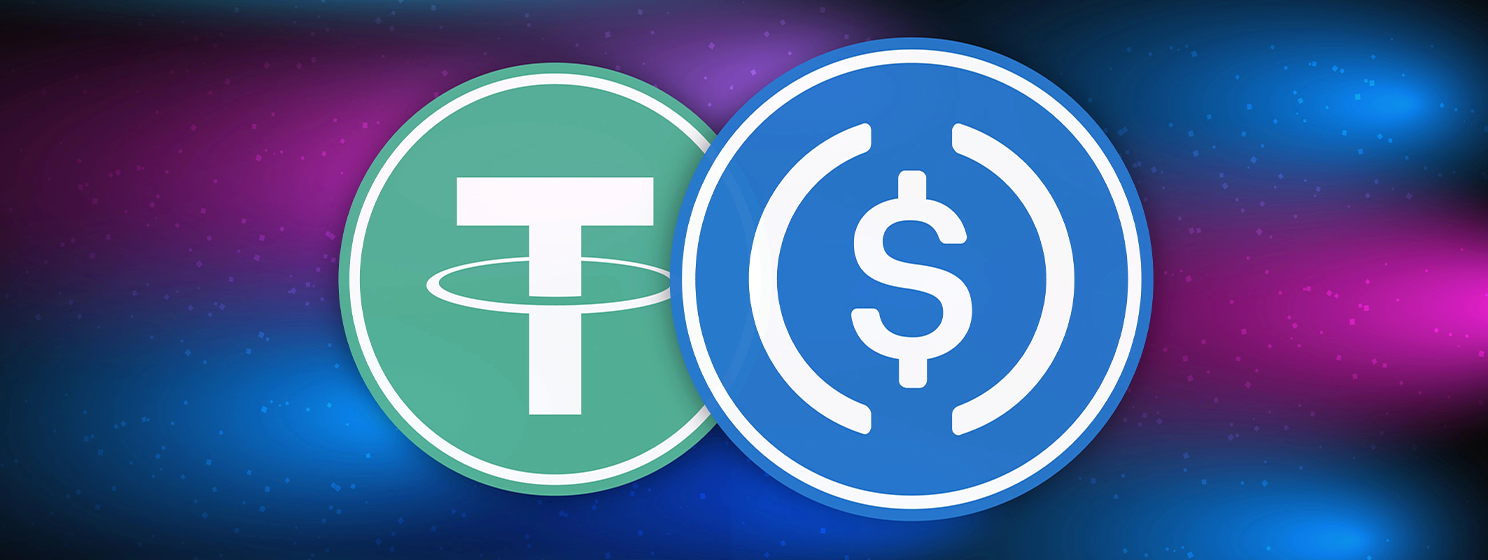|
Getting your Trinity Audio player ready...
|
Today’s stablecoin giants will have to defend their hard-won turf as competitors flood the zone, that is, until everyone realizes that the bulk of stablecoin activity is driven by bots.
- Incumbents to fall?
- Tether-USAT-Rumble; Northern Data raids
- Circle partners with Deutsche Borse, EU regulator says not so fast
- Bank of England op-ed offers stablecoin hope
- Stable bots bleep blorp
On October 1, blockchain investor Nic Carter posted a lengthy X article titled “The stablecoin duopoly is ending.” The article addressed the utter dominance exerted over the U.S. dollar-denominated stablecoin market by USDT-issuer Tether and USDC-issuer Circle (NASDAQ: CRCL).
The two tokens’ combined market caps (USDT $175.8 billion, USDC $74 billion) claim a roughly 85% share of the overall stablecoin market. Their closest competitor, Ethena’s USDe, has a cap of only $14.8 billion, and $9 billion of that only arrived in the past three months.
But the duopoly has seen better days, as their market cap peaked in March 2024 at 91.6%. Carter believes the current percentage will continue to decline due to “new assertiveness by intermediaries, a race to the bottom with yield, and new regulatory dynamics” following President Donald Trump signing the stablecoin-focused GENIUS Act into law in July.
The yield issue is prompting more and more entities to opt for white-labeled stablecoins rather than surrender the interest revenue on stablecoin fiat reserves to Tether/Circle. The number of issuing platforms/tools is multiplying by the day, meaning entities/protocols have more options than ever, allowing them a stronger position from which to negotiate with stablecoin issuers for a share of their yield.
But the willingness of new stables to share their yield sets up a ‘race to the bottom’ scenario that could cut margins to the bone, particularly if the Federal Reserve continues to cut interest rates (and these cuts will accelerate dramatically once Fed chair Jerome Powell ages out of the job next year and Trump appoints a more pliant replacement).
So for the moment, let’s check in with what the stablecoin market’s dynamic duo have been up to lately.
Tether denies knowledge of Northern Data tax shenanigans
Tether execs were all over this week’s Token2049 event in Singapore, with their primary focus being the imminent (but still unscheduled) launch of USAT, the company’s new U.S.-facing (and purportedly GENIUS-compliant) stablecoin. On October 1, Bloomberg reported that Tether would use the Rumble (NASDAQ: RUM) conservative video-streaming platform—in which Tether holds a 48% stake following a $775 million investment last December—to help distribute USAT to the masses.
Tether CEO Paolo Ardoino claimed Rumble has “51 million active users,” although Rumble has been accused in the past of inflating these stats by counting anyone who visits the site as a user rather than counting registered accounts. Moreover, Rumble’s monthly active user metric fell 14% from Q1 to Q2 2025, so this USAT distribution scheme may not prove the immediate bonanza that Ardoino forecasts.
Rumble has been promoting the launch of its in-house digital wallet for some time now and the launch was supposed to occur in Q3. Whenever it arrives, Rumble CEO Chris Pavlovski said the wallet will be “central” to growing the reach of Tether’s stablecoins, including USAT, USDT and the gold-based XAUT, as well as BTC.
Ardoino told the Singapore audience that his target for UAST’s market cap “in the next three to five years would be about $1 trillion.” Ardoino claimed this jaw-dropping figure was “realistic because of the velocity at which we are seeing USDT grow.”
In Europe, another of Tether’s major investments is not having the greatest autumn. On September 26, Bloomberg reported that German authorities had raided the offices of Northern Data AG, a former block reward miner turned artificial intelligence (AI) data center provider. Tether first invested in Northern Data in 2023, later boosting its stake in the company to a controlling 51%.
The German authorities are reportedly probing Northern Data’s former mining operations in Sweden. Swedish authorities arrested four individuals the same week as the German raids, part of an investigation into suspected “large-scale” value-added tax (VAT) fraud and money laundering by three Northern Data subsidiaries in Sweden between 2021 and 2024. The scale of this alleged fraud reportedly tops €100 million.
On October 1, Bloomberg updated its reporting to reveal that prosecutors were probing whether Northern Data illegally claimed a tax break on a €500 million purchase of high-performance computer chips.
Northern Data reportedly claimed that a 2023 purchase of 10,000 Nvidia (NASDAQ: NVDA) chips were intended for use in AI data centers, but authorities believe the chips were actually intended to boost Northern Data’s mining operations. Mining operations are subject to Swedish taxes, while AI operations enjoy tax incentives.
In September 2023, Tether promoted its strategic investment in Northern Data, as well as the purchase of the Nvidia chips. Tether said at the time that it would collaborate with Northern Data on “several initiatives that aim to leverage AI, peer-to-peer communications, and super-resilient data storage solutions.”
A Tether spokesperson told Bloomberg that the company “is not involved in the day-to-day management of [Northern Data] and was not aware of any such investigations prior to these reports.”
The German raids came shortly after Northern Data promoted COO John Hoffman to co-CEO alongside Aroosh Thillainathan. In 2024, two former senior execs at Northern Data’s U.S. division filed a civil suit accusing Thillainathan of knowingly masterminding a tax-avoidance strategy that potentially netted Northern Data “tens of millions of dollars.”
The suit also accused Northern Data of “falsely misrepresenting [its] financial position to potential auditors, tax advisors and investors” and engaging in “accounting and securities fraud.” The suit was dismissed later that year at the plaintiffs’ request and Northern Data issued a statement saying the former execs “acknowledged that they misunderstood/misstated the facts related to the complaint.”
Circle makes EU inroads, EU says not so fast
On September 30, Circle announced a collaboration with the Deutsche Börse Group, the German transaction services provider that runs Europe’s third-largest stock market by market cap. The parties signed a memorandum of understanding regarding including USDC and EURC (Circle’s euro-denominated stablecoin) within Deutsche Börse’s financial market infrastructure.
The parties called the MoU “a key step in advancing the regulated adoption of stablecoins across European markets,” building on Circle’s status as the first stablecoin issuer to achieve compliance with the European Union’s Markets in Crypto-Assets Regulation (MiCA).While Circle has followed all the MiCA rules that Tether has found too onerous to comply with, some European Central Bank (ECB) officials are distinctly uneasy with the proliferation of non-euro stablecoins within the EU zone. Now the European Systemic Risk Board (ESRB) is raising concerns over ‘multi-issuance’ stablecoins, aka tokens jointly issued by a combination of EU and non-EU entities.
In early September, ECB president Christine Lagarde—who chairs the ERSB—gave a speech in which she warned that, while stablecoins remain a relatively new and “novel” technology, “we do not need to wait for them to mature to realize that they are reintroducing old risks through the back door.” Lagarde expressed particular concerns over multi-issuance stablecoins.
On September 25, the ESRB held its latest general meeting, at which it declared that “third country multi-issuer schemes–with fungible stablecoins issued both in the EU and outside–have built-in vulnerabilities which require an urgent policy response.” Bloomberg reported that the ERSB approved a non-binding recommendation to ban multi-issuance stablecoins.
The ESRB warned that “multi-function groups may operate under regulatory regimes [outside the EU] which are much more lenient than for financial conglomerates, raising the question of divergent prudential standards.”
The ESRB argued that the EU could be left holding the (empty) bag in the event of some panic that sparks a critical mass of token-holders to redeem their stablecoins for cash. MiCA requires stablecoin issuers to hold a significant portion of their reserves at a financial institution based in an EU member state.
The ERSB’s theory is that the majority of a multi-issuance stablecoin’s holders could seek to redeem their stablecoins in the EU where the fiat reserve rules are more strictly enforced, rather than try to redeem them in the non-EU jurisdiction in which the token is also issued (and thus not subject to MiCA reserve guidelines).
Should the EU-based reserves prove insufficient to match the redemption requests, the ECB could be forced to intervene with cash of its own to protect EU token holders (much as the U.S. Federal Deposit Insurance Corporation had to intervene when Silicon Valley Bank failed in 2003, taking $3.3 billion of Circle’s USDC cash reserves with it).
Precisely what all this means for MiCA-licensed stablecoin issuers like Circle and Paxos remains to be seen. Circle is licensed in France, while Paxos got its MiCA diploma (which allows holders to operate across all EU member states) in Finland. Neither company has so far commented publicly on the ERSB recommendation.
Bank of England has change of heart?
A less alarmist take came from a somewhat surprising source this week. Andrew Bailey, governor of the Bank of England (BoE), penned an op-ed in the Financial Times in which he stated that it would “be wrong to be against stablecoins as a matter of principle.” Bailey said he recognized stablecoins’ “potential in driving innovation in payments systems both at home and across borders.”
That said, Bailey cited three concerns the stablecoin sector must address, starting with fiat reserves being “free of financial risk in terms of credit, interest and exchange rate risk.” Second, stablecoins require “an insurance scheme (as with bank deposits), and a statutory resolution arrangement that ensures their holders are preferred creditors in any insolvency process.”
Third, a stablecoin’s terms of exchange “must be known, consistent and enduring. They must be the same for all holders and must be direct into other forms of money, and not dependent on a so-called crypto exchange and its terms of business. As presently set up, not all stablecoins satisfy this condition.”
In July, Bailey told The Times of his concerns that stablecoins could take “money out of the banking system” and the “credit creation world.” (This argument is quite popular stateside at present.) But Bailey’s FT column said it is possible for banks and stablecoins to co-exist and for “non-banks” to shoulder some of the burden of “credit provision.” But the BoE needs to “consider the implications of such a change thoroughly before going ahead.”
The BoE is preparing to release a consultation paper on the UK’s “systemic stablecoin regime” in the coming months, establishing the standards that issuers will have to meet. Bailey said one of the foregone conclusions is that “widely used UK stablecoins should have access to accounts at the BoE in order to reinforce their status as money.”
Bleep blort stable
While stablecoins have demonstrated real utility when it comes to cross-border remittances and helping consumers in countries with unstable currencies (Argentina, Venezuela, etc.) preserve the value of their savings, a new report claims the vast majority of stablecoin transactions are conducted not by humans, but by bots.
The CEX.io exchange’s Q3 report claims that, while the volume of stablecoin transactions hit a record $15.6 trillion in the three months ending September 30—nearly triple the volume in the same period last year— around 71% of those transactions were conducted by bots. Another 9% were the result of smart contracts and intra-exchange transfers, leaving only around 20% of stablecoin transactions conducted manually by actual humans.
CEX.io analyst Illya Otychenko told Cointelegraph that the bot category included both high-frequency trading bots and wash trading activities intended to pump the value of this or that token. As a result, “a significant portion” of overall stablecoin volume “may not reflect meaningful economic usage.”
On a more positive note, stablecoin transactions valued under $250—considered indicative of ‘retail’ usage—surged to an all-time high in Q3, with the total volume of these transactions expected to top $60 billion by year’s end. While nearly 88% of these small transactions were linked to exchange trading, non-trading retail activity is up over 15% this year.
Watch: Bringing the Metanet to life with Teranode

 12-23-2025
12-23-2025 




